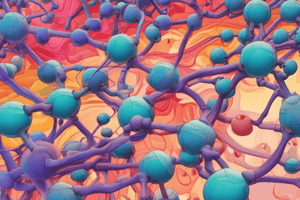Podcast
Questions and Answers
What is the minimum number of steps required for an addition polymerization reaction?
What is the minimum number of steps required for an addition polymerization reaction?
- Two
- One
- Four
- Three (correct)
What is the role of an initiator in radical polymerization?
What is the role of an initiator in radical polymerization?
- To break homolytically into radicals (correct)
- To oxidize the monomer
- To react with the monomer
- To terminate the polymer chain growth
What is the propagating site in radical polymerization?
What is the propagating site in radical polymerization?
- The monomer unit
- The end of the polymer chain
- The unpaired electron (correct)
- The start of the polymer chain
What happens when two chains combine at their propagating sites in termination steps?
What happens when two chains combine at their propagating sites in termination steps?
How many subunits are added to the chain in each propagation step?
How many subunits are added to the chain in each propagation step?
What is the result of disproportionation in termination steps?
What is the result of disproportionation in termination steps?
How many mechanisms of polymerization are mentioned in the text?
How many mechanisms of polymerization are mentioned in the text?
What is the role of the monomer in radical polymerization?
What is the role of the monomer in radical polymerization?
What type of shift can lead to a more stable carbocation during cationic polymerization?
What type of shift can lead to a more stable carbocation during cationic polymerization?
What is the characteristic of the initiator in anionic polymerization?
What is the characteristic of the initiator in anionic polymerization?
What is the purpose of substituents in the monomer during cationic polymerization?
What is the purpose of substituents in the monomer during cationic polymerization?
What type of polymer is formed during anionic polymerization?
What type of polymer is formed during anionic polymerization?
What is the characteristic of the propagating site in unrearranged cationic polymerization?
What is the characteristic of the propagating site in unrearranged cationic polymerization?
What is the reason for the nucleophilic attack not occurring readily on an alkene?
What is the reason for the nucleophilic attack not occurring readily on an alkene?
What is the result of a 1,2-hydride shift during cationic polymerization?
What is the result of a 1,2-hydride shift during cationic polymerization?
Why must the alkene contain electron-withdrawing substituents in anionic polymerization?
Why must the alkene contain electron-withdrawing substituents in anionic polymerization?
What is the primary mechanism of formation of nylon 6?
What is the primary mechanism of formation of nylon 6?
Which of the following polyesters is formed by the transesterification of dimethyl terephthalate with 1,4-di(hydroxymethyl)cyclohexane?
Which of the following polyesters is formed by the transesterification of dimethyl terephthalate with 1,4-di(hydroxymethyl)cyclohexane?
What is the characteristic feature of epoxy resins?
What is the characteristic feature of epoxy resins?
What is the functional group present in polyurethanes?
What is the functional group present in polyurethanes?
What is the monomer requirement for the formation of nylon 6?
What is the monomer requirement for the formation of nylon 6?
What is the name of the starting material used for the synthesis of nylon 6?
What is the name of the starting material used for the synthesis of nylon 6?
What is the characteristic feature of nylon 66?
What is the characteristic feature of nylon 66?
What is the purpose of the hardener in epoxy cement?
What is the purpose of the hardener in epoxy cement?
Flashcards are hidden until you start studying
Study Notes
Addition Polymers
- Chain-growth polymerization proceeds by three mechanisms: radical, cationic, and anionic polymerization.
- Each mechanism has three distinct steps: initiation, propagation, and termination.
Radical Polymerization
- Initiation step: a radical initiator is added to the monomer to generate the radical that starts the growth of the polymer chain.
- Propagation steps: the monomer radical reacts with another monomer, converting it into a radical, and the process is repeated.
- Termination steps: may occur by chain combination or disproportionation.
Cationic Polymerization
- Initiation step: a chain-initiating step occurs.
- Propagation steps: chain-propagating steps occur.
- Termination step: the carbocation intermediates undergo rearrangement by either a 1,2-hydride shift or a 1,2-methyl shift.
- The best monomers have substituents that stabilize the positive charge at the propagating site.
Anionic Polymerization
- The initiator is a nucleophile that reacts with the monomer to form an anion propagating site.
- The alkene must contain electron-withdrawing substituents to decrease the electron density of the double bond.
Classes of Step-Growth Polymers
- Polyamides
- Polyesters
- Epoxy Resins
- Polyurethanes
Polyamides
- Nylon 6 is an example of a step-growth polymer formed from a monomer with two different functional groups.
- Nylon 6 is formed from the polymerization of 6-aminohexanoic acid, which contains six carbons.
- The starting material for the synthesis of nylon 6 is ε-caprolactam.
- Nylon 66 is formed by two different bifunctional monomers—adipoyl chloride and 1,6-hexanediamine.
Polyesters
- Polymers containing many ester groups.
- Dacron is made by the transesterification of dimethyl terephthalate with ethylene glycol.
- Kodel polyester is formed by the transesterification of dimethyl terephthalate with 1,4-di(hydroxymethyl)cyclohexane.
Epoxy Resins
- They are the strongest adhesives known and are extensively cross-linked systems.
- Epoxy cement is consisting of a low-molecular-weight prepolymer and a hardener that react when mixed to form a cross-linked polymer.
Polyurethanes
- A urethane is a compound that has an OR group and an NHR group bonded to the same carbonyl carbon.
Studying That Suits You
Use AI to generate personalized quizzes and flashcards to suit your learning preferences.





